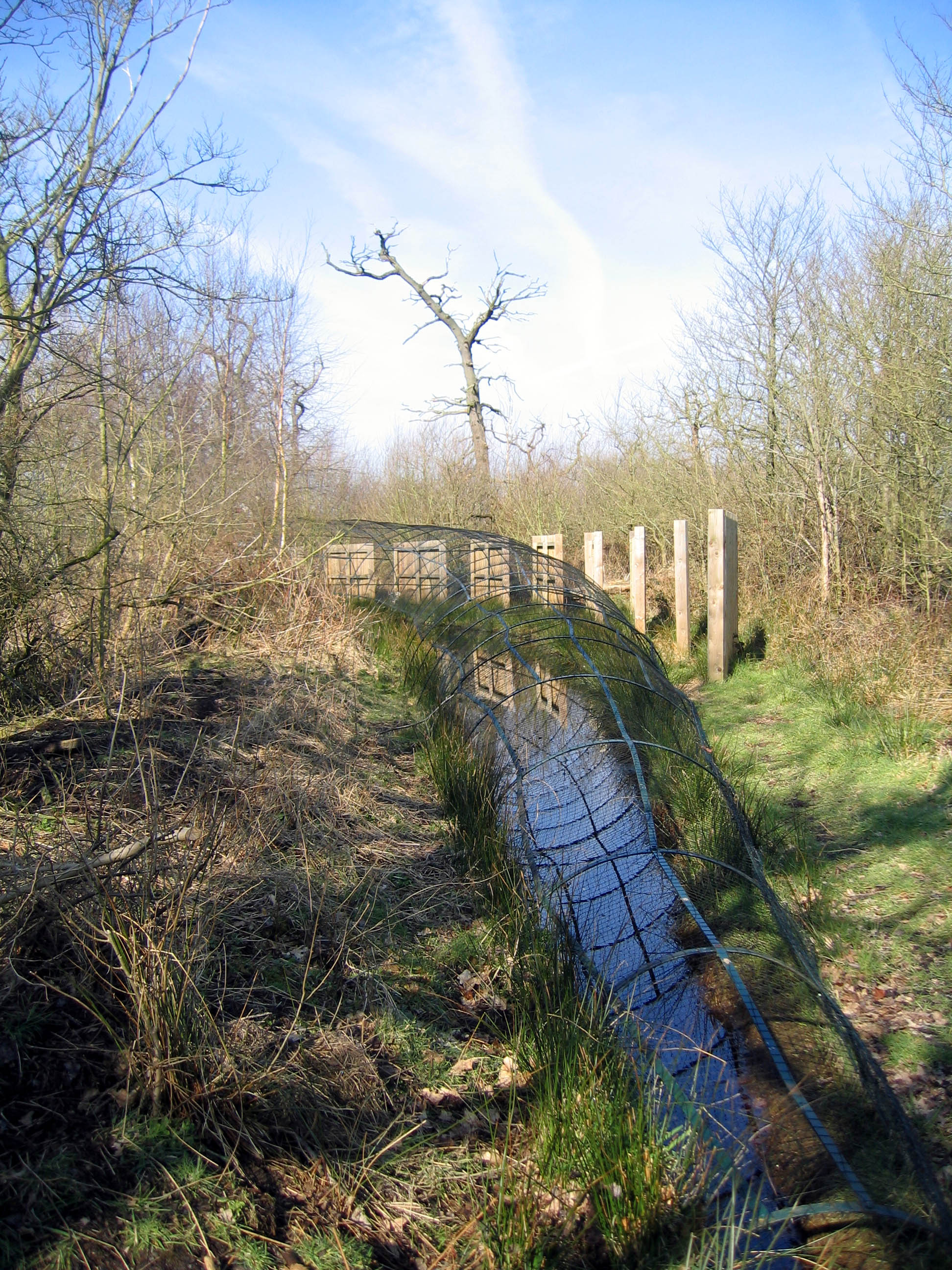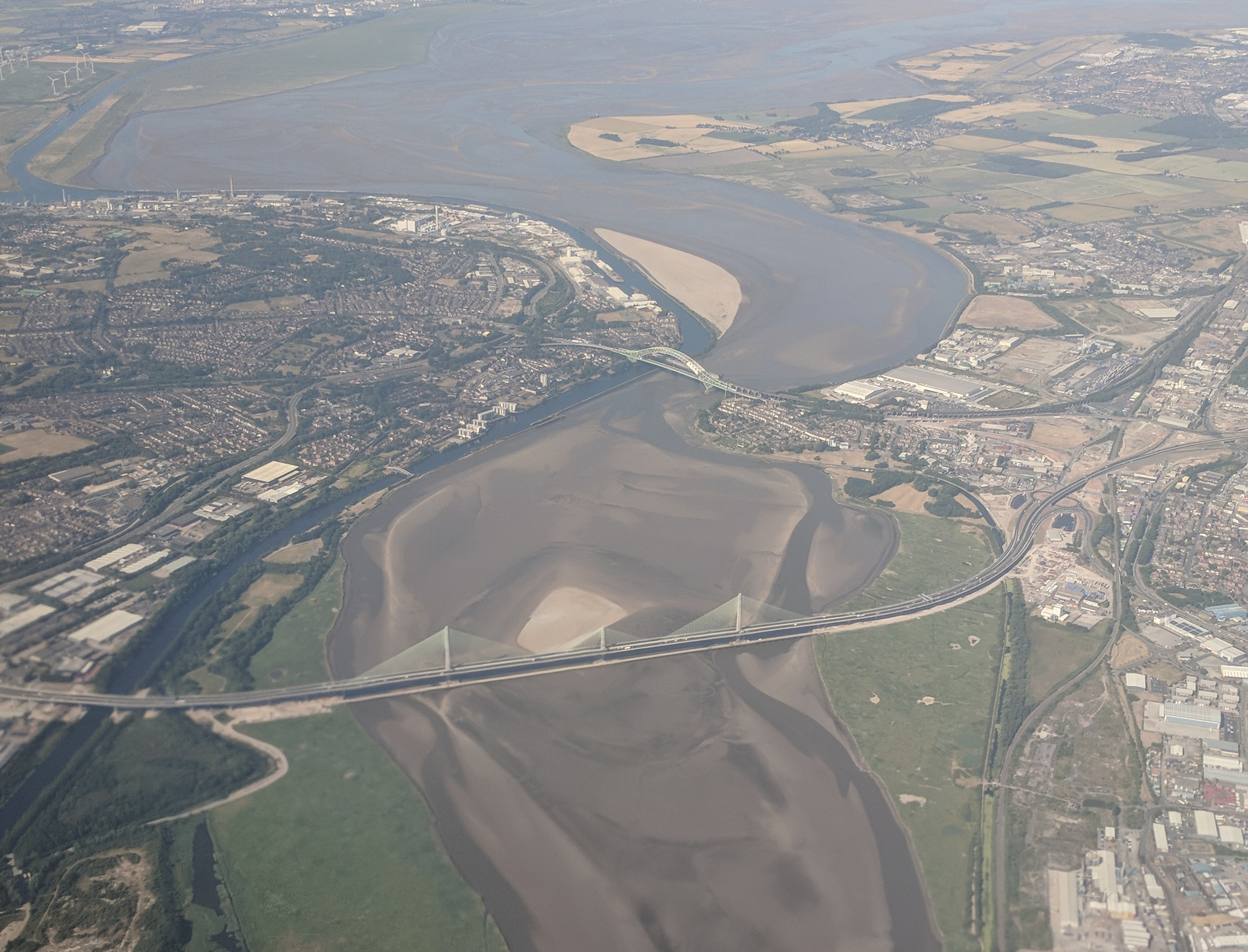|
Hale Duck Decoy
Hale Duck Decoy is a duck decoy and nature reserve near the village of Hale, in Halton, Cheshire, England. The site is a Scheduled Ancient Monument and a Site of Special Scientific Interest. It is owned by the Fleetwood-Hesketh Estate and managed by Halton Borough Council together with a group of volunteers. History The precise date of the construction of the duck decoy is not known, but there is evidence that it was built in the 17th century. Records show that in 1754 it was repaired and improved by its owner at that time, Colonel J. Blackburne. The decoy was part of the estate of Hale Hall, which had been owned by the Ireland Blackburne family since the 1600s. In the 1930s the estate was bought by the Fleetwood-Hesketh family, who still own it, but the decoy was allowed to deteriorate. In 1975 restoration of the site began, and it became a local nature reserve. The lease was taken over by Cheshire County Council, who sub-leased it to the Cheshire and Lancashire Con ... [...More Info...] [...Related Items...] OR: [Wikipedia] [Google] [Baidu] |
Salt Marsh
A salt marsh or saltmarsh, also known as a coastal salt marsh or a tidal marsh, is a coastal ecosystem in the upper coastal intertidal zone between land and open saltwater or brackish water that is regularly flooded by the tides. It is dominated by dense stands of salt-tolerant plants such as herbs, grasses, or low shrubs. These plants are terrestrial in origin and are essential to the stability of the salt marsh in trapping and binding sediments. Salt marshes play a large role in the aquatic food web and the delivery of nutrients to coastal waters. They also support terrestrial animals and provide coastal protection. Salt marshes have historically been endangered by poorly implemented coastal management practices, with land reclaimed for human uses or polluted by upstream agriculture or other industrial coastal uses. Additionally, sea level rise caused by climate change is endangering other marshes, through erosion and submersion of otherwise tidal marshes. However, r ... [...More Info...] [...Related Items...] OR: [Wikipedia] [Google] [Baidu] |
Sites Of Special Scientific Interest In Cheshire
Site most often refers to: * Archaeological site * Campsite, a place used for overnight stay in an outdoor area * Construction site * Location, a point or an area on the Earth's surface or elsewhere * Website, a set of related web pages, typically with a common domain name It may also refer to: * Site, a National Register of Historic Places property type * SITE (originally known as ''Sculpture in the Environment''), an American architecture and design firm * Site (mathematics), a category C together with a Grothendieck topology on C * ''The Site'', a 1990s TV series that aired on MSNBC * SITE Intelligence Group, a for-profit organization tracking jihadist and white supremacist organizations * SITE Institute, a terrorism-tracking organization, precursor to the SITE Intelligence Group * Sindh Industrial and Trading Estate, a company in Sindh, Pakistan * SITE Centers, American commercial real estate company * SITE Town, a densely populated town in Karachi, Pakistan * S.I.T.E Indust ... [...More Info...] [...Related Items...] OR: [Wikipedia] [Google] [Baidu] |
Borough Of Halton
("Industry fills the ship") , image_skyline = Runcorn Bridge - geograph.org.uk - 1701094.jpg , imagesize = , image_caption = The Silver Jubilee Bridge at dusk , image_flag = , flag_size = , image_seal = , seal_size = , image_shield = , shield_link = , shield_size = , image_blank_emblem = , blank_emblem_size = 200px , blank_emblem_type = Arms of Halton Borough Council , blank_emblem_link = , mapsize = 250px , map_caption = Halton shown within Cheshire , image_map = Halton UK locator map.svg , image_dot_map = , dot_mapsize = , dot_map_caption = , dot_x = , dot_y ... [...More Info...] [...Related Items...] OR: [Wikipedia] [Google] [Baidu] |
Tourist Attractions In Cheshire
Tourism is travel for pleasure or business; also the theory and practice of touring, the business of attracting, accommodating, and entertaining tourists, and the business of operating tours. The World Tourism Organization defines tourism more generally, in terms which go "beyond the common perception of tourism as being limited to holiday activity only", as people "travelling to and staying in places outside their usual environment for not more than one consecutive year for leisure and not less than 24 hours, business and other purposes". Tourism can be domestic (within the traveller's own country) or international, and international tourism has both incoming and outgoing implications on a country's balance of payments. Tourism numbers declined as a result of a strong economic slowdown (the late-2000s recession) between the second half of 2008 and the end of 2009, and in consequence of the outbreak of the 2009 H1N1 influenza virus, but slowly recovered until the COVID-19 p ... [...More Info...] [...Related Items...] OR: [Wikipedia] [Google] [Baidu] |
Scheduled Monuments In Cheshire
There are over 600 scheduled monuments in Cheshire Cheshire ( ) is a ceremonial and historic county in North West England, bordered by Wales to the west, Merseyside and Greater Manchester to the north, Derbyshire to the east, and Staffordshire and Shropshire to the south. Cheshire's county tow ..., dating from pre-history to the present. For ease of reference these are split into three lists by period: * List of scheduled monuments in Cheshire dated to before 1066 * List of scheduled monuments in Cheshire (1066–1539) * List of scheduled monuments in Cheshire since 1539 {{DEFAULTSORT:Scheduled monuments in Cheshire * ... [...More Info...] [...Related Items...] OR: [Wikipedia] [Google] [Baidu] |
Decoys
A decoy (derived from the Dutch ''de'' ''kooi'', literally "the cage" or possibly ''ende kooi'', " duck cage") is usually a person, device, or event which resembles what an individual or a group might be looking for, but it is only meant to lure them. Decoys have been used for centuries most notably in game hunting, but also in wartime and in the committing or resolving of crimes. Hunting In hunting wildfowl, the term decoy may refer to two distinct devices. One, the duck decoy (structure), is a long cone-shaped wickerwork tunnel installed on a small pond to catch wild ducks. After the ducks settled on the pond, a small, trained dog would herd the birds into the tunnel. The catch was formerly sent to market for food, but now these are used only by ornithologists to catch ducks to be ringed and released. The word ''decoy'', also originally found in English as "coy", derives from the Dutch ''de Kooi'' (the cage) and dates back to the early 17th century, when this type of d ... [...More Info...] [...Related Items...] OR: [Wikipedia] [Google] [Baidu] |
List Of Scheduled Monuments In Cheshire (post-1539)
There are over two hundred scheduled monuments in Cheshire, a county in North West England, which date from the Neolithic period to the middle of the 20th century. This list includes the scheduled monuments in Cheshire from 1540 to the present, the periods accepted by ''Revealing Cheshire's Past'' as post-medieval and modern. A scheduled monument is a nationally important archaeological site or monument which is given legal protection by being placed on a list (or "schedule") by the Secretary of State for Culture, Media and Sport; English Heritage takes the leading role in identifying such sites. The current legislation supporting this is the Ancient Monuments and Archaeological Areas Act 1979. The term "monument" can apply to the whole range of archaeological sites, and they are not always visible above ground. Such sites have to have been deliberately constructed by human activity. They range from prehistoric standing stones and burial sites, through Roman remains and mediev ... [...More Info...] [...Related Items...] OR: [Wikipedia] [Google] [Baidu] |
Heritage At Risk
An annual ''Heritage at Risk Register'' is published by Historic England. The survey is used by national and local government, a wide range of individuals and heritage groups to establish the extent of risk and to help assess priorities for action and funding decisions. This heritage-at-risk data is one of the UK government's official statistics. ''Heritage at risk'' is term for cultural heritage assets that are at risk as a result of neglect, decay, or inappropriate development; or are vulnerable to becoming so. England's ''Heritage at Risk Register'' The ''Heritage at Risk Register'' covers: * Grade I and II* listed buildings (the baseline register is 1999); Grade II listed buildings in London only (the baseline register is 1991) * Structural scheduled monuments (base year is 1999) and scheduled monuments (base year is 2009) * Registered parks and gardens (base year is 2009) * Registered historic battlefields (base year is 2008) * Protected wreck sites * Conservation areas ( ... [...More Info...] [...Related Items...] OR: [Wikipedia] [Google] [Baidu] |
Mersey Estuary
The River Mersey () is in North West England. Its name derives from Old English and means "boundary river", possibly referring to its having been a border between the ancient kingdoms of Mercia and Northumbria. For centuries it has formed part of the boundary between the historic counties of Lancashire and Cheshire. The Mersey starts at the confluence of the River Tame and River Goyt in Stockport. It flows westwards through south Manchester, then into the Manchester Ship Canal at Irlam, becoming a part of the canal and maintaining its water levels. After it exits the canal, flowing towards Warrington where it widens. It then narrows as it passes between Runcorn and Widnes. From Runcorn the river widens into a large estuary, which is across at its widest point near Ellesmere Port. The course of the river then turns northwards as the estuary narrows between Liverpool and Birkenhead on the Wirral Peninsula to the west, and empties into Liverpool Bay. In total the river flows . ... [...More Info...] [...Related Items...] OR: [Wikipedia] [Google] [Baidu] |
Heritage Lottery Grant
The National Lottery Heritage Fund, formerly the Heritage Lottery Fund (HLF), distributes a share of National Lottery funding, supporting a wide range of heritage projects across the United Kingdom. History The fund's predecessor bodies were the National Land Fund, established in 1946, and the National Heritage Memorial Fund, established in 1980. The current body was established as the "Heritage Lottery Fund" in 1994. It was re-branded as the National Lottery Heritage Fund in January 2019. Activities The fund's income comes from the National Lottery which is managed by Camelot Group. Its objectives are "to conserve the UK's diverse heritage, to encourage people to be involved in heritage and to widen access and learning". As of 2019, it had awarded £7.9 billion to 43,000 projects. In 2006, the National Lottery Heritage Fund launched the Parks for People program with the aim to revitalize historic parks and cemeteries. From 2006 to 2021, the Fund had granted £254million t ... [...More Info...] [...Related Items...] OR: [Wikipedia] [Google] [Baidu] |
Duck Decoy (structure)
A duck decoy is a device to capture wild ducks or other species of waterfowl. Decoys had an advantage over hunting ducks with shotguns as the duck meat did not contain lead shot. Consequently, a higher price could be charged for it. Decoys are still used for hunting ducks, but they are now also used for ornithological research, in which the birds are released after capture. Etymology The word ''decoy'' is derived from the Dutch word ''eendenkooi'', which means "duck-cage"; ''Chambers Dictionary'' suggests Dutch ''de kooi'' = "the cage". Description Screens by a duck decoy pipe in a nature reserve near Waardenburg, the Netherlands (2007) As finally developed the decoy consisted of a pool of water leading from which are from one to eight curving, tapering, water-filled ditches. Over each ditch is a series of hoops, initially made from wood, later from iron, which diminish in size as the ditch tapers. The hoops are covered in netting. The combination of ditch and net-covered ... [...More Info...] [...Related Items...] OR: [Wikipedia] [Google] [Baidu] |






